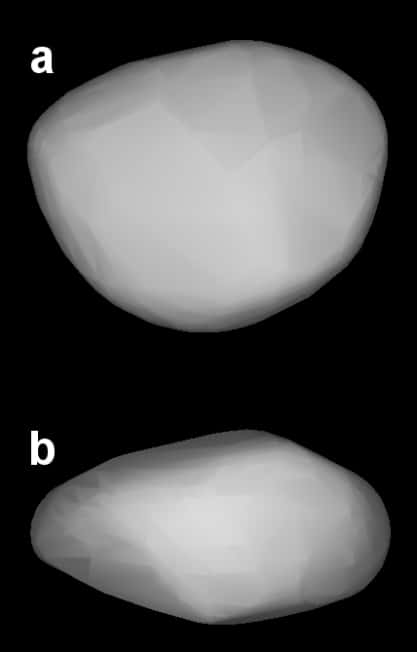Astronomers in the US and Europe have proved that sunlight plays a key role in how fast asteroids rotate. The rotation is caused by the small torque given to an asteroid when previously absorbed solar radiation is re-emitted. This mechanism -- known as the "YORP" effect -- has now been seen for the first time in two asteroids, and could be the reason behind the odd distribution of rotations seen in asteroid families.

Large asteroids rotate at a range of different speeds, roughly following a bell-shaped “Gaussian” distribution in which most rotate at a speed close to some average, with only a small proportion rotating much faster or much slower then the norm. However, the distribution for asteroids with a diameter less than 10 km is rather different – their families have a large excess of asteroids rotating at the fast and slow extremes.
Researchers had thought that the odd distributions could be a result of infrared photons from the Sun warming an asteroid’s near surface as they are absorbed. These absorbed photons are re-emitted once the surface turns away from the Sun, making the asteroid recoil a tiny amount each time they depart. Although a symmetrical asteroid would be unaffected by these recoils, an irregularly-shaped asteroid would experience a net torque that increases the speed of its rotation over millions of years – the so-called “YORP” effect (named after its originators Yarkovsky, O’Keefe, Radzievskii and Paddack). However, the torque would be so small that it would only cause a significant rotation in small asteroids.
Now, two different groups have accumulated enough optical and radar observations from ground-based telescopes to prove that the YORP effect can indeed produce the odd distributions of small asteroids. A team led by Stephen Lowry from Queen’s University in Belfast in the UK (Science Express doi: 10.1126/science1139040) has analyzed data collected over four years by Patrick Taylor and colleagues (Science Express doi: 10.1126/1139038) of “2000 PH5”, an asteroid with a diameter just over 100 m. They found that 2000 PH5 is gradually rotating faster – currently, it takes 12 minutes to rotate, but in 500,000 years time the YORP effect will have halved that period.
Meanwhile, Mikko Kaasalainen from the University of Helsinki in Finland and colleagues (Nature doi:10.1038/nature05614) have shown that the rotation of the larger asteroid “1862 Apollo” with a radius of 700 m is also increasing because of the YORP effect – but nearly a hundred times slower.
Although past data have hinted at the YORP effect, this is the first time astronomers have been able to rule out other possible causes of rotation acceleration, such as strong “tidal torques” caused by the Earth’s gravity and collisions. “A collision would cause a one-time change in spin rate, not a continuous change,” Taylor told Physics Web. “The odds of a single collision for 2000 PH5 is about one collision per billion years – a collision per year is simple unreasonable.”
The teams also say that the YORP effect could speed up the rotation of asteroids to such an extent that they overcome their own gravity and break into halves, producing a “binary” asteroid system.



